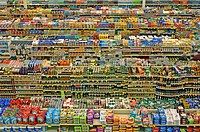
Photo from wikipedia
Hydrocolloids are naturally occurring polysaccharides or proteins, which are used to gelatinize, modify texture, and thicken food products, and are also utilized in edible films and drug capsule production. Moreover,… Click to show full abstract
Hydrocolloids are naturally occurring polysaccharides or proteins, which are used to gelatinize, modify texture, and thicken food products, and are also utilized in edible films and drug capsule production. Moreover, several hydrocolloids are known to have a positive impact on human health, including prebiotics rich in bioactive compounds. In this paper, plant-derived hydrocolloids from arrowroot (Maranta arundinacea), kuzu (Pueraria montana var lobata), Sassafras tree (Sassafras albidum) leaves, sugarcane, acorn, and animal-derived gelatin have been reviewed. Hydrocolloid processing, utilization, physicochemical activities, composition, and health benefits have been described. The food industry generates waste such as plant parts, fibers, residue, scales, bones, fins, feathers, or skin, which are often discarded back into the environment, polluting it or into landfills, where they provide no use and generate transport and storage costs. Food industry waste frequently contains useful compounds, which can yield additional income if acquired, thus decreasing the environmental pollution. Despite conventional manufacturing, the aforementioned hydrocolloids can be recycled as byproducts, which not only minimizes waste, lowers transportation and storage expenses, and boosts revenue, but also enables the production of novel, functional, and healthy food additives for the food industry worldwide.
Journal Title: Molecules
Year Published: 2022
Link to full text (if available)
Share on Social Media: Sign Up to like & get
recommendations!